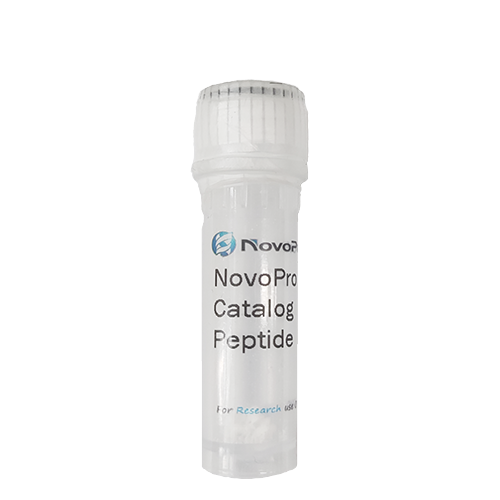CALP1 peptide
Not For Human Use, Lab Use Only.
Cat.#: 300910
Special Price 101.20 USD
-
Product Name
CALP1 peptide
-
Documents
Batch to batch variation of the purity
-
Sequence Shortening
VAITVLVK
-
Sequence
H-Val-Ala-Ile-Thr-Val-Leu-Val-Lys-OH
-
Length (aa)
8
-
Peptide Purity (HPLC)
97%
-
Molecular Formula
C40H75N9O10
-
Molecular Weight
842.09
-
CAS No.
145224-99-3
-
Source
Synthetic
-
Form
Powder
-
Description
CALP1 is an octameric peptide designed to interact with EF-hand motifs, which are calcium-binding domains found in proteins such as calmodulin (CaM). The peptide exhibits a complementary surface contour to an eight-amino-acid stretch within the loop sequence of EF hands, enabling specific binding. CALP1 has been shown to bind the EF hands of CaM, forming a peptide/CaM complex that can modulate calcium-sensitive processes. The peptide is capable of entering cells and influencing calcium-permeable channels, such as glutamate receptor channels and nonselective cation channels, through direct or indirect interactions involving CaM.
CALP1 demonstrates the ability to block calcium influx by targeting the regulatory mechanisms of ion channels rather than their pore regions or ligand-binding sites. Single-channel analysis reveals that CALP1 modulates channel activity by altering open probability and conductance. Its interaction with calcium-sensing domains highlights its role as a novel calcium channel blocker, distinct from traditional inhibitors. The peptide's effects are reversible, indicating a non-accumulative and targeted mechanism of action.
-
Storage Guidelines
Normally, this peptide will be delivered in lyophilized form and should be stored in a freezer at or below -20 °C. For more details, please refer to the manual: Handling and Storage of Synthetic Peptides
-
References
- Manion MK, Su Z, Villain M, Blalock JE. A new type of Ca(2+) channel blocker that targets Ca(2+) sensors and prevents Ca(2+)-mediated apoptosis. FASEB J. 2000 Jul;14(10):1297-306. doi: 10.1096/fj.14.10.1297. PMID: 10877822.
-
About TFA salt
Trifluoroacetic acid (TFA) is a common counterion from the purification process using High-Performance Liquid Chromatography (HPLC). The presence of TFA can affect the peptide's net weight, appearance, and solubility.
Impact on Net Weight: The TFA salt contributes to the total mass of the product. In most cases, the peptide content constitutes >80% of the total weight, with TFA accounting for the remainder.
Solubility: TFA salts generally enhance the solubility of peptides in aqueous solutions.
In Biological Assays: For most standard in vitro assays, the residual TFA levels do not cause interference. However, for highly sensitive cellular or biochemical studies, please be aware of its presence.
-
Molar Concentration Calculator
-
Dilution Calculator
-
Percent Concentration Calculator
Mass (g) = Concentration (mol/L) × Volume (L) × Molecular Weight (g/mol)
Related Products / Services
• Peptide Services: NovoPro's peptide synthesis services include standard chemical peptide synthesis, peptide modification, peptide libraries, and recombinant peptide expression.
• Standard Peptide Synthesis: NovoPro offers quality peptides at the most competitive prices in the industry, starting at $3.20 per amino acid. NovoPro provides PepBox – Automatic Quote Tool for online price calculation.
• Peptide Modifications: NovoPro offers a wide range of peptide modification services including isotope labeling (2H, 15N, and 13C), multiple disulfide bonds, multiple phosphorylations, KLH, BSA, ovalbumin, amidation, acetylation, biotin, FITC, etc.
Please note: All products are "FOR RESEARCH USE ONLY AND ARE NOT INTENDED FOR DIAGNOSTIC OR THERAPEUTIC USE"

